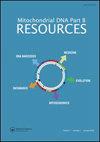陈玉林、陈玉林、陈玉林等。1984(菊科)。
IF 0.5
4区 生物学
Q4 GENETICS & HEREDITY
Mitochondrial DNA. Part B, Resources
Pub Date : 2024-12-23
eCollection Date: 2025-01-01
DOI:10.1080/23802359.2024.2444605
引用次数: 0
摘要
中国植物属(Sinosenecio B. Nordenstam, 1978)是一个具有复杂的内属关系的极具挑战性的分类群。在此,我们新报道了S. eriopodus (Cumm.)的质体基因组。C. Jeffrey & Y. L. Chen(1984)。全基因组为典型的二次型结构,总大小为151,212 bp,包含132个基因。本研究首次揭示了matK和rpoA基因在sinsenecio中为正选择基因。基于全质体基因组序列的系统发育重建表明,S. eriopodus不属于sinsenecio S. oldhamianus类群的单系分支,而是与Asteraceae Tussilaginae s.s.亚族中的某些属有密切的亲缘关系。本文章由计算机程序翻译,如有差异,请以英文原文为准。
The plastid genome and phylogenetic status of Sinosenecio eriopodus C. Jeffrey & Y. L. Chen 1984 (Asteraceae).
The genus Sinosenecio B. Nordenstam (1978) is a challenging taxonomic group with complex infrageneric relationships. Here, we newly report the plastid genome of S. eriopodus (Cumm.) C. Jeffrey & Y. L. Chen (1984). Whole genome exhibited a typical quadratic structure with a total size of 151,212 bp and 132 genes. We revealed for the first time that the matK and rpoA were positively selected genes within Sinosenecio. Phylogenetic reconstruction based on whole plastid genome sequences indicated that S. eriopodus was not clustered into a monophyletic clade with members belonging to the S. oldhamianus group of Sinosenecio but rather was closely related to some genera in the subtribe Tussilaginae s.s. of Asteraceae.
求助全文
通过发布文献求助,成功后即可免费获取论文全文。
去求助
来源期刊

Mitochondrial DNA. Part B, Resources
Biochemistry, Genetics and Molecular Biology-Molecular Biology
CiteScore
1.30
自引率
20.00%
发文量
670
期刊介绍:
This open access journal publishes high-quality and concise research articles reporting the sequence of full mitochondrial genomes, and short communications focusing on the physical, chemical, and biochemical aspects of mtDNA and proteins involved in mtDNA metabolism and interactions.
 求助内容:
求助内容: 应助结果提醒方式:
应助结果提醒方式:


